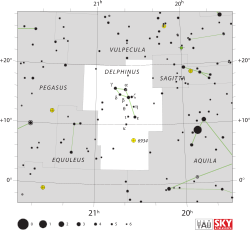Delta Delphini
| Observation data Epoch J2000.0 Equinox J2000.0 | |
|---|---|
| Constellation | Delphinus |
| Right ascension | 20h 43m 27.53338s[1] |
| Declination | +15° 04′ 28.4773″[1] |
| Apparent magnitude (V) | 4.43[2] (4.38 - 4.49)[3] |
| Characteristics | |
| Spectral type | kA7hF0mF0(IV-V)[4] |
| B−V color index | +0.302[2] |
| Variable type | δ Sct[3] |
| Astrometry | |
| Radial velocity (Rv) | 9.48±0.07[5] km/s |
| Proper motion (μ) | RA: −20.44[1] mas/yr Dec.: −43.33[1] mas/yr |
| Parallax (π) | 14.61 ± 0.20[1] mas |
| Distance | 223 ± 3 ly (68.4 ± 0.9 pc) |
| Absolute magnitude (MV) | +0.25[6] |
| Orbit[5] | |
| Primary | δ Del A |
| Companion | δ Del B |
| Period (P) | 40.60505±0.00014 d |
| Semi-major axis (a) | 5.4676±0.0037 |
| Eccentricity (e) | 0.64008±0.00018 |
| Inclination (i) | 13.92±0.18° |
| Longitude of the node (Ω) | 63.73±0.33° |
| Periastron epoch (T) | 56823.5019±0.0028 MJD |
| Argument of periastron (ω) (secondary) | 65.07±0.32° |
| Semi-amplitude (K1) (primary) | 13.88±0.14 km/s |
| Semi-amplitude (K2) (secondary) | 15.27±0.07 km/s |
| Details | |
| δ Del A | |
| Mass | 1.78[5] M☉ |
| Radius | 3.9[7] R☉ |
| Luminosity | 59.9[8] L☉ |
| Surface gravity (log g) | 3.71[9] cgs |
| Temperature | 7,226±246[9] K |
| Metallicity [Fe/H] | −0.07±0.05[10] dex |
| Rotational velocity (v sin i) | 29.4[2] km/s |
| Age | 945[9] Myr |
| δ Del B | |
| Mass | 1.62[5] M☉ |
| Other designations | |
| Database references | |
| SIMBAD | data |
Delta Delphini, Latinized from δ Delphini, is a binary star[12] in the northern constellation of Delphinus. It is visible to the naked eye with an apparent visual magnitude of 4.43.[2] Based upon an annual parallax shift of 14.61 mas as seen from the Earth,[1] the system is located about 223 light years from the Sun.
This is a double-lined spectroscopic binary[12] system with an orbital period of 40.58 days.[12] The two components are nearly identical chemically peculiar stars, having a combined stellar classification of kA7hF0mF0(IV-V).[4] This notation indicates the calcium K line matches an A7 star, the hydrogen lines an F0 star, and the metal lines an F0 star. Each of the stars is a Delta Scuti variable, with the system having a dominant period of 0.1568 days and an amplitude of 0.0700 in magnitude.[2] Delta Delphini forms the prototype of a class of metal-lined δ Scuti subgiant or giant stars.[13]
References[]
- ^ a b c d e f van Leeuwen, F. (2007), "Validation of the new Hipparcos reduction", Astronomy and Astrophysics, 474 (2): 653–664, arXiv:0708.1752, Bibcode:2007A&A...474..653V, doi:10.1051/0004-6361:20078357, S2CID 18759600.
- ^ a b c d e Chang, S.-W.; et al. (2013), "Statistical Properties of Galactic δ Scuti Stars: Revisited", The Astronomical Journal, 145 (5): 132, arXiv:1303.1031, Bibcode:2013AJ....145..132C, doi:10.1088/0004-6256/145/5/132, S2CID 118900730.
- ^ a b Samus, N. N.; Durlevich, O. V.; et al. (2009). "VizieR Online Data Catalog: General Catalogue of Variable Stars (Samus+ 2007-2013)". VizieR On-line Data Catalog: B/GCVS. Originally Published in: 2009yCat....102025S. 1. Bibcode:2009yCat....102025S.
- ^ a b Gray, R. O.; Garrison, R. F. (1989), "The early F-type stars - Refined classification, confrontation with Stromgren photometry, and the effects of rotation", Astrophysical Journal Supplement Series, 69: 301, Bibcode:1989ApJS...69..301G, doi:10.1086/191315.
- ^ a b c d Gardner, Tyler; et al. (2018). "Precision Orbit of δ Delphini and Prospects for Astrometric Detection of Exoplanets". The Astrophysical Journal. 855 (1). 1. arXiv:1802.00468. Bibcode:2018ApJ...855....1G. doi:10.3847/1538-4357/aaac80. S2CID 7642698.
- ^ Anderson, E.; Francis, Ch. (2012), "XHIP: An extended hipparcos compilation", Astronomy Letters, 38 (5): 331, arXiv:1108.4971, Bibcode:2012AstL...38..331A, doi:10.1134/S1063773712050015, S2CID 119257644.
- ^ Pasinetti Fracassini, L. E.; et al. (February 2001), "Catalogue of Apparent Diameters and Absolute Radii of Stars (CADARS)", Astronomy and Astrophysics (3rd ed.), 367: 521–524, arXiv:astro-ph/0012289, Bibcode:2001A&A...367..521P, doi:10.1051/0004-6361:20000451, S2CID 425754.
- ^ McDonald, I.; et al. (2012), "Fundamental Parameters and Infrared Excesses of Hipparcos Stars", Monthly Notices of the Royal Astronomical Society, 427 (1): 343–57, arXiv:1208.2037, Bibcode:2012MNRAS.427..343M, doi:10.1111/j.1365-2966.2012.21873.x, S2CID 118665352.
- ^ a b c David, Trevor J.; Hillenbrand, Lynne A. (2015), "The Ages of Early-Type Stars: Strömgren Photometric Methods Calibrated, Validated, Tested, and Applied to Hosts and Prospective Hosts of Directly Imaged Exoplanets", The Astrophysical Journal, 804 (2): 146, arXiv:1501.03154, Bibcode:2015ApJ...804..146D, doi:10.1088/0004-637X/804/2/146, S2CID 33401607.
- ^ Prugniel, Ph.; Vauglin, I.; Koleva, M. (July 2011), "The atmospheric parameters and spectral interpolator for the MILES stars", Astronomy & Astrophysics, 531: A165, arXiv:1104.4952, Bibcode:2011A&A...531A.165P, doi:10.1051/0004-6361/201116769, S2CID 54940439.
- ^ "del Del". SIMBAD. Centre de données astronomiques de Strasbourg. Retrieved 2017-06-28.CS1 maint: postscript (link)
- ^ a b c Liakos, Alexios; Niarchos, Panagiotis (February 2017), "Catalogue and properties of δ Scuti stars in binaries", Monthly Notices of the Royal Astronomical Society, 465 (1): 1181–1200, arXiv:1611.00200, Bibcode:2017MNRAS.465.1181L, doi:10.1093/mnras/stw2756
- ^ Baade, D.; Bardelli, S.; Beaulieu, J. Ph.; Vogel, S. (March 1993), "A spectroscopic search for nonradial pulsations in the Delta Scuti stars Delta Delphini and Epsilon Cephei", Astronomy and Astrophysics, 269 (1–2): 195–200, Bibcode:1993A&A...269..195B.
External links[]
- Kaler, James B. (August 3, 2007), "Delta Delphini", Stars, University of Illinois, retrieved 2017-06-28.
- A-type subgiants
- F-type subgiants
- Delta Scuti variables
- Am stars
- Spectroscopic binaries
- Delphinus (constellation)
- Bayer objects
- Flamsteed objects
- Henry Draper Catalogue objects
- Hipparcos objects
- HR objects
- Durchmusterung objects
